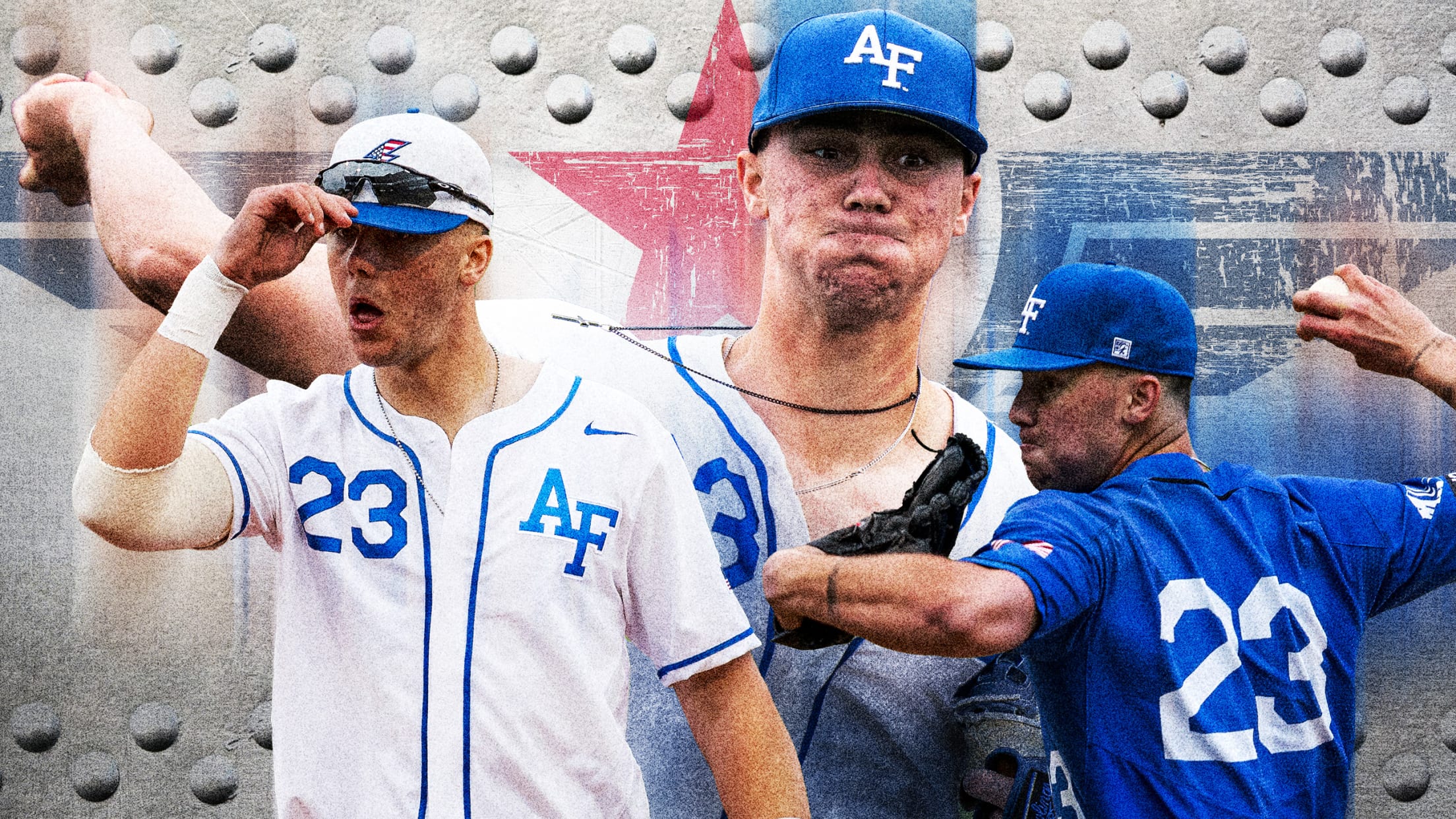
The making of Paul Skenes, a 'one in a decade' kind of pitcher

In the later part of the 2023 collegiate baseball season, the Pirates sent Dewey Robinson to Baton Rouge, La., on a scouting trip. A special advisor on pitching development, Robinson has more than 40 years of coaching experience under his belt and is one of the highest ranking members of the Pirates’ pitching team.
Like so many scouts, Robinson wanted to get eyes on the top pitching prospect in the country. The difference was the Pirates held the first overall pick in that summer’s MLB Draft. If they wanted the 6-foot-6 mustachioed, high-socks-wearing fireballer who seemingly blew up social media every time he took the mound, they could have him.
Robinson’s report from that day was brief, coming in at about two pages. It touched on his impressions of him as a pitcher, his makeup as a person, how advanced he was in his development and the two pitches that had made him a sensation: His triple-digit fastball and wipeout slider. But it was his closer at the bottom of the second page that really cemented Robinson’s feelings on the prodigy who went by the name of Paul Skenes:
We’ve got to take this guy.
“He’s one in a decade,” Robinson later told MLB.com. “You don’t get an opportunity to get a guy walking into your camp like this. Some guys you can develop over years and get to that point, but he’s walking in as that guy.”
The Pirates would go on to take Skenes, the most hyped pitching prospect of his generation, as the first overall pick that July and signed him to the largest signing bonus in MLB history. He jumped to the top of MLB Pipeline’s prospect chart, ranking as the top pitcher in the sport before he threw a professional pitch. Comparisons immediately were made to some of the greatest young pitchers of their time, namely Stephen Strasburg.
It’s been years since a Pirates prospect has generated this much hype. Skenes’ first start with Double-A Altoona set an attendance record for the Pirates affiliate, with a large portion of the crowd being Pittsburghers who made the nearly 100-mile trek east to see him in person. By Spring Training, there were plenty of calls from fans to have him start the season in the Majors.
“I don’t really know the extent of it,” Skenes said of all that noise. “I don’t really care. All that really matters is what’s in this locker room and frickin’ winning ballgames.”
Skenes’ journey is just getting started, and his Major League debut will be the most anticipated arrival of a Pirates farmhand since Andrew McCutchen. Talk to people who have watched Skenes pitch and they will share their grand visions of what he can become. There are few people who would diagnose anything less than greatness. But what’s perhaps most amazing is that this journey almost didn’t happen.
As he left for college, Skenes didn’t see baseball as a likely career. And if it was going to be, he assumed he would make it as a catcher, not a pitcher. This meteoric rise was never supposed to be in the stars.
He thought he was going to go into the military.
'He's superhuman'
Basic training at the United States Air Force Academy is not conducive to what pitchers normally do to take care of their arms. Sit-ups. Pull-ups. Self-defense. It can wipe players out. Basic training goes from late June to early August, and with the exception of intramural time, there aren’t a lot of chances for pitchers to keep their arms in top form. It’s why the first fall bullpen session of the year can be humbling.
Everyone suffers a drop in velocity in that first bullpen. It’s normal for a pitcher who was recruited throwing 90 mph to sit in the low 80s instead. Skenes wasn’t at full strength either, but there was a difference: He was still pumping 92 mph fastballs. It didn’t take long for the coaching staff to recognize that he was special.
The thing is, he wasn’t part of their rotation. He wasn’t even a full-time pitcher. While he’d go on to serve as the team’s closer his freshman year, his main focuses were hitting and catching.

“I could go on for days with stories about that kid, but the one word I always use to tell people [about] him is he’s ‘superhuman,’” said former Air Force and current Boston College pitching coach Ryan Forrest. “You’re going to hear the legends of Paul Skenes … catching six or seven innings, hit two jacks in a game and then close the last two, three [innings].”
Craig and Karen Skenes, Paul’s parents, knew by the time he turned 7 that they had a future ballplayer. He was the kid who always had a ball in his hands, the one who would put on a catcher’s mask and go into a stance while watching a game on TV.
“It’s all I’ve ever done, really,” Paul acknowledged. “The only sport I’ve ever played. I played some seasons of rec soccer, but baseball is the only sport I ever wanted to play.”
Catching was the first love, so much so that Forrest was not one of the main players in recruiting him to the Air Force. Skenes wanted to hit. He says that if he could still catch, he would. Forrest saw the “killer instinct” in Skenes that great athletes have, and catching was an avenue for him to realize it.
“I feel like he was able to assess the strengths of his teammates and use that to his team’s advantage, and I think he really enjoyed that,” said Karen Skenes. “I think that was a little bit hard to give up, more of that control and having the wider view of the game.”
Alas, there aren’t too many catchers who stand 6-foot-6 because of how low they have to get to snare those low offerings and block balls in the dirt. Even still, Forrest swears Skenes could have been a first-round pick if he stuck there.
“It just ended up that pitching is my future in the game,” Paul said.
He could certainly hit, batting .410 with 11 home runs and a 1.183 OPS in his 48-game freshman campaign. But he showed more potential on the mound. While he was limited to a relief role in order to manage his workload, Skenes still flirted with triple digits and averaged more than a strikeout an inning while racking up 11 saves. Those pitching performances would usually come after he had squatted behind the plate and caught all day beforehand, hinting that he was still only scratching the surface of his potential.
As he continued to excel, coaches from other schools started to tell the Air Force staff that if Skenes was thinking of transferring, to please keep them in mind. That included Jay Johnson, who would go on to be the head coach at Louisiana State University.
But for Skenes to do that, he would have to make two hard decisions. The first was whether converting to pitching full-time was the right move. The second was if he should leave the Air Force.
Paul Skenes the person
“This is my favorite Paul Skenes story.”
Forrest saw plenty of remarkable things from Skenes as a player, but this story was a snapshot of Skenes the person. Air Force’s baseball practice field is downhill from the practice football field, and at 4:45 p.m., the flag goes down and the national anthem plays. Earlier on this particular day, 11 Marines had died in the Middle East. Everyone was supposed to stand at attention, but two students at the football field didn’t. When the anthem finished, Skenes beelined up the hill to chew them out.
“It shows the type of person Paul Skenes is,” Forrest said. “It shows his character. It shows his morals. Shows he loves his country and has a passion for his country.”
Craig Skenes says Paul learned to speak up when he felt something needed to be said from his mother, who taught high schoolers. That story on the practice field wasn’t a one-off example. One of his duties at the Academy was grading dormitory rooms. One time, a friend asked if he could skirt by with a messy dorm. Skenes wouldn't let him. He’d also hold teammates accountable if he thought they were holding the group back.
“I think he’s got a reason to speak up,” Karen Skenes said. “When it’s military, it can be your life that’s on the line. There’s definitely a desire for those who are around you to be as good as they can be.”
“He is a leader through and through,” Forrest said. “He was going to be a great leader for our country if he decided that’s what he wanted to do, stay in the Academy.”
All three of Karen’s brothers have a military background: Two went to the Naval Academy and served, and one is still serving in the Coast Guard. As Skenes grew into a desirable high school prospect, most recruiters were told they were wasting their time. He was going to a military school, and he immersed himself fully. He flew in and pulled over 8 Gs in F-15 and F-16 jets. He took boxing classes. He did survival training.
Throughout his freshman year, he really thought his future would be in the service.
“I feel like baseball was always just a dream that was in the back of his mind,” Karen Skenes said. “It’s very hard at a professional level. It’s very hard to get to that point. So while he always would bet on himself, he also had an understanding that it was going to take a lot of things lining up the right way. A lot of luck, as well as things he can control.”

Around Christmas of his sophomore year, he started having second thoughts. Perhaps baseball could be a career. He wanted to find out, and the first step was telling Forrest that he wanted to be the Friday night starter. Forrest was delighted and was able to get the rest of the coaching staff on board, even though it meant taking one of their best bats out of the lineup.
“Closing is cool. It’s an adrenaline rush and it’s cool to finish out a game, but I didn’t think it was valuable to get a good start to the weekend,” Skenes said. “I just wanted to win games.”
Skenes still caught some and hit, again to solid results, but he opened eyes with his work on the mound. That stuff he flashed as a closer translated to a full start. If he wanted to go into the transfer portal, he would be coveted.
And he had to decide now. If he was to return for his junior year, he would have been committed to the Air Force until at least graduation and needed to fulfill his service contract.
“I realized I’ve got one shot at this,” Skenes said. “I’ve got a couple shots at serving. There are a lot of people who join the Air Force or Navy when they’re 30, 40 years old. There aren’t people who do that in baseball, so I may as well give it my best shot.
“That was the toughest decision of my life. I knew I had to do it.”
Skenes ultimately chose to transfer to LSU, because he felt they had the best pitching and hitting coach in the country. That pitching coach, Wes Johnson, would help him take that next step to more fully realize his potential.
Impressive work ethic
Bubba Chandler didn’t think Skenes was going to make him run this much.
Last offseason, the Pirates’ No. 5 prospect had been invited to join Skenes’ training sessions with Johnson, now the head coach at the University of Georgia. Chandler had already been blown away watching Skenes pitch at LSU before briefly crossing paths with him in Altoona. So of course he pounced at the chance to get a look behind the curtain.
“It’s nothing crazy, but it ain’t easy,” Chandler said with a smirk.
A lot of the work wasn’t on the mound, but giving attention to areas that don’t normally get enough love. Split squats, isometric exercises, pitching tempos for velocity, a lot of running -- maybe more running than Chandler signed up for now that he’s in his post-high school football days.
“It’s a continuation [of what we did at LSU],” Skenes said. “That’s all we’re trying to do, get better. There’s no need to reinvent the wheel.”
During those workouts, one thought kept popping back into Chandler’s head: “I can now see why LSU won a lot of games.”
“You can tell he wants it,” Chandler said. “It’s pretty evident. When they were playing in the College World Series, it’s like, ‘Damn, this guy’s pretty good. It would be cool to be teammates with him.’ We’re building something special, and he’s going to be a big part of it. He’s that type of baseball player. He’s that type of person. He’s also just a freak of nature.”
At LSU, Skenes started to find that extra gear. It was at a fall game that he first noticed that he hit 99.5 mph. He would hit 100 mph plenty of times in the spring, peaking at 102.

The consensus is that ascent was two-pronged. For one, Skenes had finally given up hitting and catching.
“I think he realized after his last game at Air Force that the path of the catching side and pitching at the same time were probably not going to be achievable,” said Craig Skenes. “I think it just created more wear and tear on him, in terms of being able to recuperate. I was surprised that he was able to perform at the level he did as long as he did.”
The second was that LSU was the right fit. He filled out his frame. A lot of that extra weight was muscle, a product of a better weight-lifting routine. He and Wes Johnson dove deep into his mechanics, including how he was landing and the weight transfer in his delivery.
“They found out where he’s losing power, using his strength, stuff like that,” Robinson said. “That’s where you can find out where you can make gains and a velo jump.”
“I don’t know if they changed my career, but they definitely got me on a better trajectory,” Skenes said.
Having a full pitching lab and a former Major League pitching coach at his disposal also meant that Skenes’ jump to professional ball was fairly seamless. It struck Robinson not only how talented this young pitcher was, but also how advanced his understanding of the game was when he wasn’t on the mound.
“Having Wes Johnson as your pitching coach is just a dream come true,” Robinson said. “Not only did he get him ready for the SEC, the [College] World Series, he was also getting him ready for the Major Leagues, too. Some of the discussions I’ve had with Wes, he was right on track with what we would be doing.”
And though Skenes was no longer catching, he fell in love with a new part of the game, what he refers to as “the art of pitching.” In college, Skenes relied almost exclusively on his four-seam fastball and slider. When he joined the Pirates organization, he wanted to give more attention to his other offerings: a curveball, a changeup and a sinker with some splitter action, which he refers to as a “splinker.” He has used those more while dominating with Triple-A Indianapolis.
“Having the fastball opens up to other things,” said Skenes, who produced a 0.99 ERA and struck out 45 over 27 1/3 Triple-A innings this year. “Same with having a really good slider; it opens up to other things. Just being able to use the full arsenal and [knowing] how often I should be throwing each pitch and that kind of thing, that’s the fun part. Putting together a plan and making it happen and getting hitters out that way, that’s what makes the game rewarding for me.”
The next step
With respect to the Altoona Curve, that record-setting crowd of 10,164 at People’s Natural Gas Field last August pales in comparison to some of the environments Skenes pitched in while with LSU. The Tigers led college baseball in attendance in 2023, selling more than 440,000 tickets.
“That was kind of the vibe at LSU, so it’s not really a foreign thing,” Skenes said with a grin.
It also gave him a taste of something new: fame. Each of his professional outings has come with fanfare and fans clamoring for his callup. It’s a seemingly different world than those Air Force games less than two years ago.
To him, it’s barely a blip on the radar. He doesn’t use social media -- a bit of a surprise given that he is dating LSU gymnast and Instagram/Tik-Tok star Olivia Dunne -- so that type of noise isn’t too hard to avoid.
“I think having self-awareness is the big thing,” Skenes said. “Just trying to have self-awareness through it all rather than fooling anybody.”
“Not to put any of it down, but there’s so much of it that’s artificial,” Karen Skenes said about the noise surrounding her son. “A lot of it’s for clicks or whatever else. He doesn’t see any of that validation. What he sees as motivation and validation is what he has control of, which is what he can do on the field or in the clubhouse, working with others.”
So, then, what is real? What is Pittsburgh getting in this guy?
“[He’s] an unbelievable competitor, an unbelievable person that every kid in the city of Pittsburgh should look up to,” Forrest said.
They are also getting one of the top pitching prospects in recent memory, someone with seemingly boundless potential and a promise for the future.
That’s where the focus is right now: on the future.
“Paul’s goal is not to make it to the Majors,” Karen Skenes said. “Paul’s goal is bigger than that. Each step is a step that has to be gone through successfully. I know when he plays games, it’s not one inning at a time or one batter at a time. It’s one pitch at a time. I think his career is going to be built that way, also. He’s not just trying to make it to the Majors. He’s trying to build something bigger.”
“I believe that -- that I’m going to throw well for a long time,” Paul Skenes added. “That’s what I work on every day.”
Alex Stumpf covers the Pirates for MLB.com.
